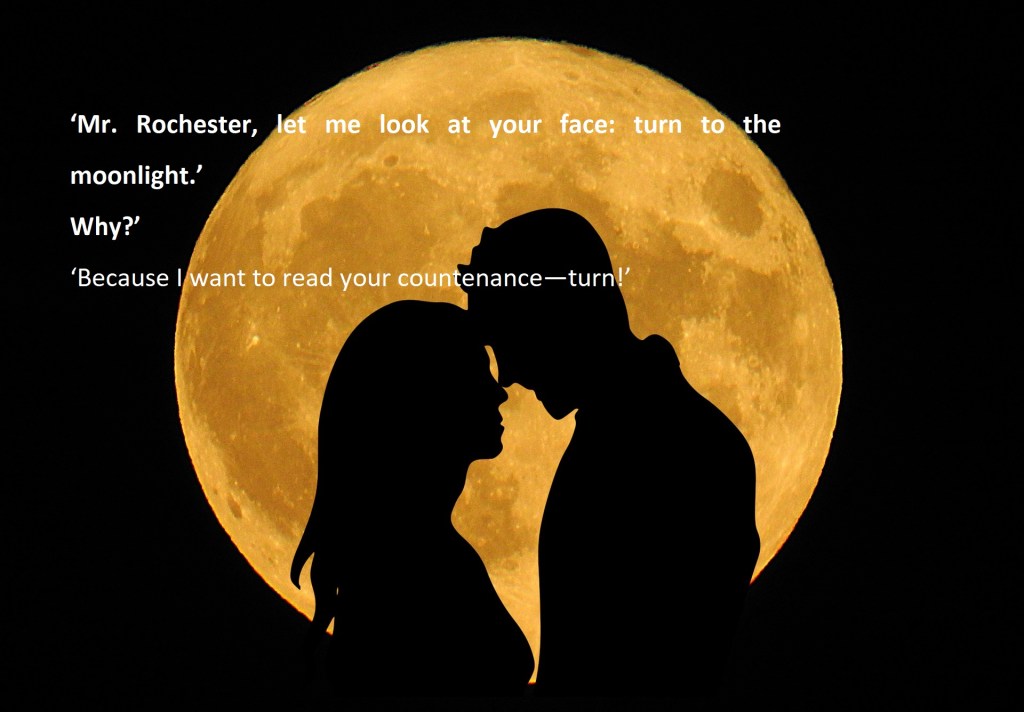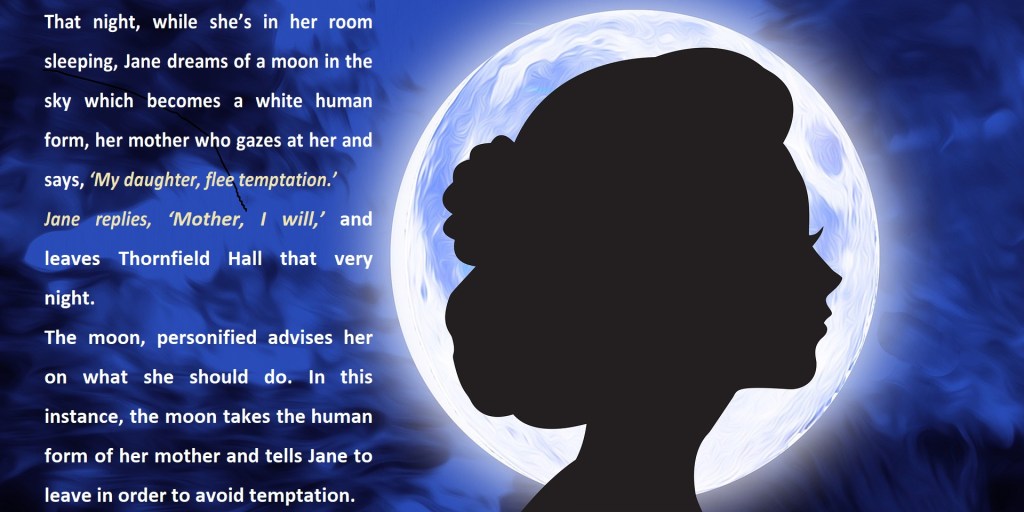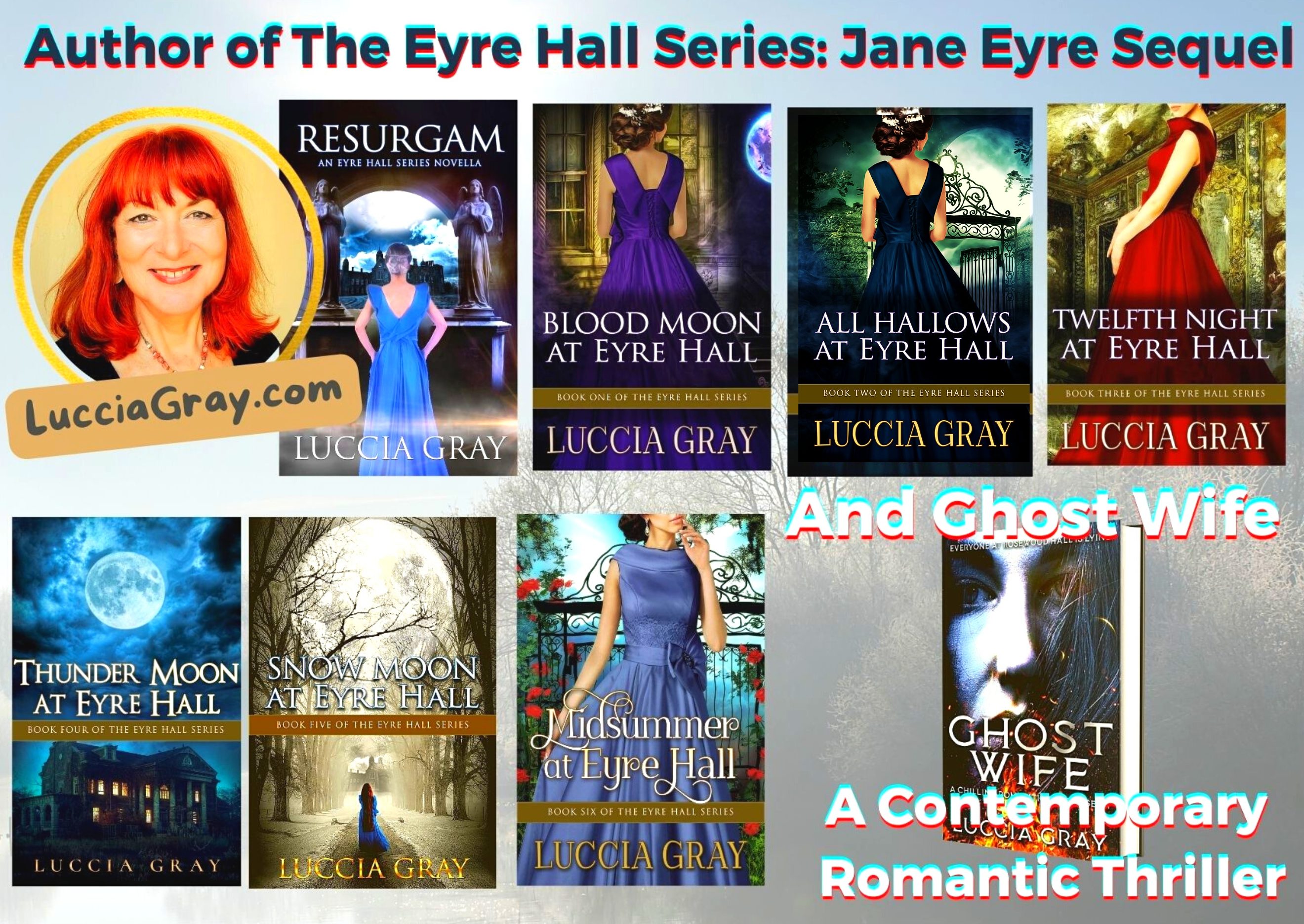This post is the third and final one about The Moon In Jane Eyre. For a complete overview of the moon in Jane Eyre, read The Moon in Jane Eyre Part One and The Moon in Jane Eyre Part Two.
During a walk with Adele on the grounds of Thornfield Hall, we understand why the full moon is a negative omen of betrayal. Mr Rochester tells Jane about the moonlit night he surprised Adele’s mother, the French opera singer, Celine Varens, with her lover.
“It was moonlight and gaslight besides, and very still and serene. The balcony was furnished with a chair or two.”
Mr Rochester tells Jane he realised she was using him for his money, as he was paying for all her expenses, but she was unfaithful, so he left her that very night, withdrew her allowance, and challenged the young officer to a duel.
- The first time Jane saw the door to the hidden room where Bertha was kept prisoner, in chapter XX, was a full moon.
I had forgotten to draw my curtain, which I usually did, and also to let down my window-blind. The consequence was, that when the moon, which was full and bright (for the night was fine), came in her course to that space in the sky opposite my casement, and looked in at me through the unveiled panes, her glorious gaze roused me. Awaking in the dead of night, I opened my eyes on her disk—silver- white and crystal clear. It was beautiful, but too solemn; I half rose, and stretched my arm to draw the curtain.
And then she heard cries asking for help coming from the third storey. All the guests who were staying at Thornfield rushed out. Mr Rochester came down from the direction of the cries and sent them all to bed. Then he knocked on Jane’s door and took her upstairs to nurse Mason while he fetched the doctor.
Her visit to the tapestried room was terrifying. Behind the tapestry, which had been looped to one side she saw a hidden door and heard a snarling sound from within and Grace Poole’s voice.
Here the moon, which wakes her up and is ‘too solemn’ is warning Jane of danger ahead.
- Jane enjoys drawing and the moon figures frequently in her illustrations. While she is at Thornfield Jane returns to Gateshead to her aunt’s, she draws some pictures including a rising moon.
Provided with a case of pencils, and some sheets of paper, I used to take a seat apart from them, near the window, and busy myself in sketching fancy vignettes, representing any scene that happened momentarily to shape itself in the ever-shifting kaleidoscope of imagination: a glimpse of sea between two rocks; the rising moon, and a ship crossing its disk; a group of reeds and water-flags, and a naiad’s head, crowned with lotus-flowers, rising out of them; an elf sitting in a hedge-sparrow’s nest, under a wreath of hawthorn- bloom.
The rising moon, and a ship crossing its disk, would suggest that Jane foresees a journey, or at least a change in her life. At this point, Jane has acknowledged that he is in love with Mr Rochester, but she believes he will marry Blanche, so she has resolved to leave Thornfield. She trusts the moon to guide her along to her new destination.
- Shortly after her return to Thornfield Hall, Mr Rochester proposes to Jane on a full moon evening.
Jane went out to the garden as night fell. On seeing Mr Rochester, she tried to slip away, but he asked her to stay and watch the moonrise.
‘Turn back: on so lovely a night it is a shame to sit in the house; and surely no one can wish to go to bed while sunset is thus at meeting with moonrise.’
At first, he teases her by telling her she must go to Ireland, because he will marry Blanche. When Jane rises to leave, he proposes. She thinks he is lying and insists on looking at his face in the moonlight.

‘Mr. Rochester, let me look at your face: turn to the moonlight.’
Why?’
‘Because I want to read your countenance—turn!’
The light of the moon allows Jane to see that his offer is sincere, si she accepts. They stay in the garden, talking all night until the moon was almost set, and she could no longer see his face.
- The day after she has accepted his proposal, Adele, Jane, and Rochester go shopping to Millcote. In the carriage Rochester tells Adele he will take Jane to the moon where they will live in a cave and eat manna, which grows there plentifully.
I am to take mademoiselle to the moon, and there I shall seek a cave in one of the white valleys among the volcano-tops, and mademoiselle shall live with me there, and only me.’
‘She will have nothing to eat: you will starve her,’ observed Adele.
‘I shall gather manna for her morning and night: the plains and hillsides in the moon are bleached with manna, Adele.’
‘She will want to warm herself: what will she do for a fire?’
‘Fire rises out of the lunar mountains: when she is cold, I’ll carry her up to a peak, and lay her down on the edge of a crater.’
I suggest Mr Rochester is using moon symbolism and metaphor to describe the sexual relationship he hopes to have with Jane, but his dream-like description of their honeymoon is open to diverse interpretations.
- One full moon night, a month after the proposal while Mr. Rochester was absent from home on business, Jane experienced a disturbing event.
She woke thinking it was daylight, but when she opened her eyes, there was candlelight on the dressing-table. Jane supposed Sophie had come in, but the closet door, where her wedding dress and veil were hanging, was open, and she heard a rustling noise. She thought it was Sophie, but and a form she had never seen before emerged from the closet. She describes a monster; a tall, corpulent woman with thick, dark hair hanging long down her back, wearing a white dress. She had bloodshot eyes with black eyebrows, purple skin and swollen dark lips. She took Jane’s veil tore it in two, threw it on the floor and trampled on it.
Then she stood by her bedside, glared at her, thrust up her candle close to her face, and extinguished it under her eyes. Jane was terrified and lost consciousness.
Mr Rochester was gone and she was terrified of staying inside the house that night without him, so she went out in the moonlit night in search of him. As before, Jane looks to the moon to guide her to a better place.
The following day, after their interrupted wedding, Mr Rochester has asked her to stay with him despite being married and suggested they live as husband and wife in his house in France. Jane of course refuses, she is too clever to become another woman abandoned by Rochester when he tires of her. Jane is in a desperate quandary. She doesn’t want to leave Mr Rochester, but neither can she stay and be his mistress.
That night, while she’s in her room sleeping, she dreams of a moon in the sky which becomes a white human form, her mother who gazes at her and says, ‘My daughter, flee temptation.’
Jane replies, ‘Mother, I will,’ and leaves Thornfield Hall that very night.

The moon, personified advises her on what she should do. In this instance, the moon takes the human form of her mother and tells Jane to leave in order to avoid temptation.
We cannot be sure if Jane is referring to her biological mother or Mary, the mother of God, her spiritual mother, or perhaps both. As the symbolism of the Virgin Mary is a major part of catholic doctrine and Jane is an Anglican, I would be inclined to assume that she is referring to her own mother. This is the only time Jane actively thinks about or refers to her mother in the novel.
At Moor House in Morton, the night before her cousin St John left for India, Jane, who had already turned down his proposal, has an auditory extrasensory experience.
In the evening while St John, Mary, Diana, and Jane are reading before prayers, the May moon is shining brightly through the uncurtained window, rendering almost unnecessary the light of the candle on the table.
It was later that full moon night when one of the most dramatic scenes in the novel takes place.
‘The room was full of moonlight. My heart beat fast and thick: I heard its throb. Suddenly it stood still to an inexpressible feeling that thrilled it through, and passed at once to my head and extremities. The feeling was not like an electric shock, but it was quite as sharp, as strange, as startling: it acted on my senses as if their utmost activity hitherto had been but torpor, from which they were now summoned and forced to wake. They rose expectant: eye and ear waited while the flesh quivered on my bones.
Jane heard Mr Rochester’s voice cry out her name three times.
‘I am coming!’ she cried. ‘Wait for me! Oh, I will come!’ and the following day she returned to Thornfield Hall.
- Days later, when she finds him in Ferndean Mr Rochester tells her that a few nights earlier, while he was watching the full moon, he called her name three times in desperation.
‘Did you speak these words aloud?’
‘I did, Jane. If any listener had heard me, he would have thought me mad: I pronounced them with such frantic energy.’
He also tells her he heard her reply.
‘As I exclaimed ‘Jane! Jane! Jane!’ a voice—I cannot tell whence the voice came, but I know whose voice it was—replied, ‘I am coming: wait for me.’
Rochester states that, ‘In spirit, I believe we must have met…perhaps your soul wandered from its cell to comfort mine.’
So here at the end of the novel, the moon becomes a positive omen for both, carrying their voices and feelings across space, simultaneously. From then on, they will both remember the night of the full moon they contacted each other supernaturally, and as a result they were reunited. The moon’s final appearance in the novel is the central element to the grand finale. Jane and Rochester’s love is like the tide, controlled by the moon, who pulls them together in the novel’s final happy ever after.
If you enjoyed my posts on The Moon in Jane Eyre, be sure to read all my other posts on Jane Eyre here.
Subscribe to my newsletter here and never miss a post or an update.


It is very interesting to read about these sections of the book like this. It makes an interesting connection.
LikeLiked by 2 people
Thanks Robbie. I’m glad you thought so. I’m preparing an AtoZ of Jane Eyre to be published in the autumn, with lots of information and insights on the novel, gathered over decades of rereading.
LikeLiked by 2 people
I will look out for it, Luccia. The Brontes and their books have always fascinated me. I have known about the Bronte sisters all my life it seems.
LikeLike
Looking forward to the A to Z, Luccia!
LikeLiked by 1 person